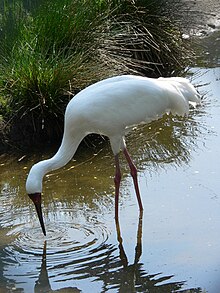Siberian crane
| Siberian crane | |
|---|---|
 |
|
| A captive individual in a zoo | |
| Scientific classification | |
| Kingdom: | Animalia |
| Phylum: | Chordata |
| Class: | Aves |
| Order: | Gruiformes |
| Family: | Gruidae |
| Genus: | Grus |
| Species: | Grus leucogeranus |
| Binomial name | |
|
Grus leucogeranus Pallas, 1773 |
|
 |
|
| Migration routes, breeding and wintering sites | |
| Synonyms | |
|
Bugeranus leucogeranus |
|
Bugeranus leucogeranus
Sarcogeranus Ieucogeranus
The Siberian crane (Leucogeranus leucogeranus), also known as the Siberian white crane or the snow crane, is a bird of the family Gruidae, the cranes. They are distinctive among the cranes, adults are nearly all snowy white, except for their black primary feathers that are visible in flight and with two breeding populations in the Arctic tundra of western and eastern Russia. The eastern populations migrate during winter to China while the western population winters in Iran and formerly, in India and Nepal. Among the cranes, they make the longest distance migrations. Their populations, particularly those in the western range, have declined drastically in the 20th century due to hunting along their migration routes and habitat degradation. The world population was estimated in 2010 at about 3,200 birds, mostly belonging to the eastern population with about 95% of them wintering in the Poyang Lake basin in China, a habitat that may be altered by the Three Gorges Dam. In western Siberia there are only around ten of these cranes in the wild.
Adults of both sexes have a pure white plumage except for the black primaries, alula and primary coverts. The forecrown, face and side of head is bare and brick red, the bill is dark and the legs are pinkish. The iris is yellowish. Juveniles are feathered on the face and the plumage is dingy brown. There are no elongated tertial feathers as in some other crane species. During breeding season, both the male and female cranes are often seen with mud streaking their feathers. They dip their beaks in mud and smear it on their feathers. The call is very different from the trumpeting of most cranes and is a goose-like high pitched whistling toyoya. They typically weigh 4.9–8.6 kg (11–19 lb) and stand about 140 cm (55 in) tall. The wingspan is 210–230 cm (83–91 in) and length is 115–127 cm (45–50 in). Males are on average larger than females. There is a single record of an outsized male of this species weighing 15 kg (33 lb).
The Siberian crane was formally described by Pallas in 1773, although Ustad Mansur, a 17th-century court artist and singer of Jahangir, had illustrated a Siberian crane about 100 years earlier. The genus Megalornis was used for the cranes by Gray and this species was included in it, while Bowdler Sharpe suggested a separation from Grus and used the genus Sarcogeranus. The Siberian crane lacks the complex tracheal coils found in most other cranes but shares this feature with the wattled crane. The unison call differed from that of most cranes and some authors suggested that the Siberian crane belonged in the genus Bugeranus along with the wattled crane. Comparisons of the DNA sequences of cytochrome-b however suggest that the Siberian crane is basal among the Gruinae and the wattled crane is retained as the sole species in the genus Bugeranus and placed as a sister to the Anthropoides cranes.
...
Wikipedia

